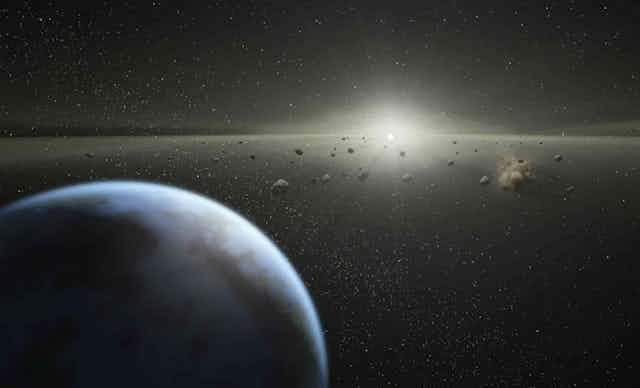Millions of asteroids of all shapes and sizes are littered throughout the inner solar system. In the past three decades, scientists have spotted as many as 500,000 but many more remain unseen. Many of them have a “rubble pile” internal structure, which is rather unusual compared to other bodies in the solar system.
In a paper published in Nature today, researchers from the University of Tennessee, led by Benjamin Rozitis, have solved the mystery of how small rubble-pile asteroids are held together.
Rubble-pile asteroids are exactly what they sound like – a grouping of different sized rocks brought together under the influence of gravity. Its constituent pieces could be anything from large boulders tens of meters in size to dust particles smaller than a thousandth of a meter in diameter.
Until now it was assumed that the main forces that hold all these pieces together were gravity and friction. But a rubble-pile asteroid named (29075) 1950 DA, with a diameter of 1.3km, is an exceptional case.
This revelation comes from observing how fast asteroids spin. For instance, if a rubble-pile asteroid spins too fast, the particles within it will overcome the forces that hold them together and fly off into empty space.
Measurements of the rate at which asteroids spin have been made for thousands of asteroids of all sizes. It was seen that none of them could spin faster than about one rotation every 2.2 hours. (The exceptions are small asteroids made up of a solid chunk of rock called monoliths, tens to hundreds of metres in size. These are sturdy enough not to fly apart while spinning at higher rates.)
Asteroid (29075) 1950 DA, it turns out, is one of those rare asteroids which spins faster than this limit. A body of this size and shape, spinning as fast as it does – once every 2.12 hours to be exact – should not be able to hold on to its constituent parts, at least around its equatorial region. This is unless it has a high enough density to create the gravitational force required to hold on to the dust particles. This density needs to be about 3.5 times higher than water. But measurements showed it was much lower. Something more than gravity and friction was needed for (29075) 1950 DA to exist.
The answer lies not in gravity or friction alone, but additional weak forces created by the tiny grains that “stick” together to form a kind of cement between the larger pieces. The binding forces at play, known as van der Waals forces, are very weak. They are an intrinsic property of matter that start acting when two atoms come close enough to each other. Electrons in an atom create a magnetic field that attracts the electrons from nearby atoms. This creates a very slight charge imbalance created that holds the atoms together weakly.
Rozitis and colleagues were able to use past data from NASA’s WISE infrared space observatory and a new form of thermal modelling to determine its density. They worked out that its density was just 1.7 times the density of water. This a not nearly dense enough to reason that gravity and friction were responsible for holding the rubble-pile together. The only explanation is that weak cement-like forces are present within the asteroid.
At the molecular level, van der Waals forces may be weak, but collectively, they can accomplish impressive feats. For instance, geckos’ remarkable grip, which allows them to hold on to glass, are the result of these forces. The tiny hairs on its skin get close enough to a surface to let van der Waals forces do their magic.
Beyond the gecko grip
This research may have potential implications for dealing with a hazardous asteroid on a collision course with the Earth. Rozitis notes that a projectile colliding with such a fast-spinning small rubble-pile asteroid could easily lead to its complete disintegration. This means all the forces that hold the asteroid together beyond its gravity could be violently destabilised. The cement crumbles away and centrifugal forces instantly take over to tear the asteroid apart.
Asteroid (29075) 1950 DA has one of the most well-determined predicted future orbits of any asteroid and is established as one of the highest risk objects of an Earth collision – albeit in 2880, if it happens at all. Perhaps by then, this research will help us deal with the threat.

